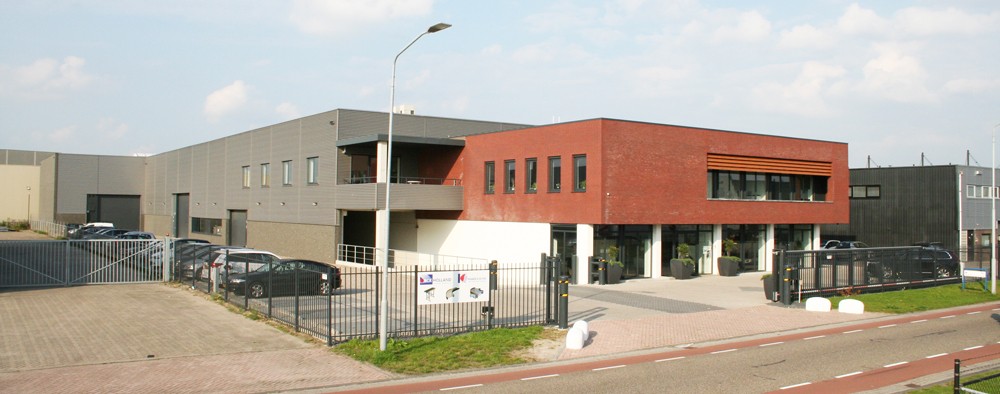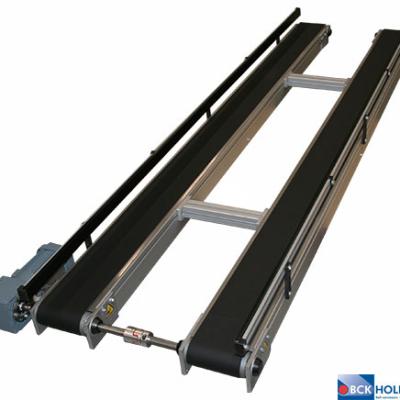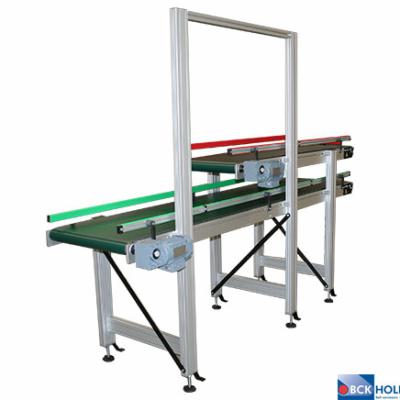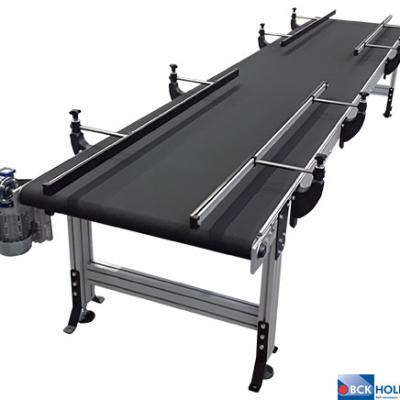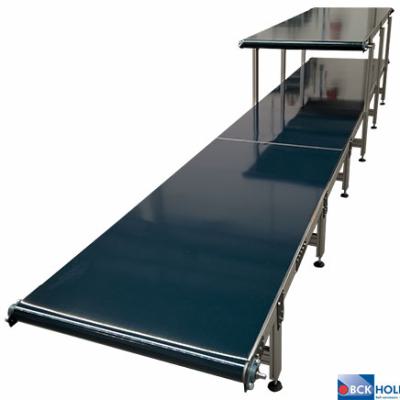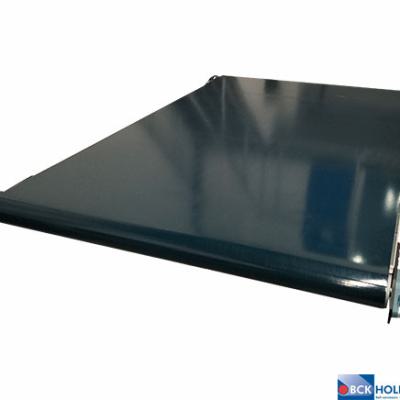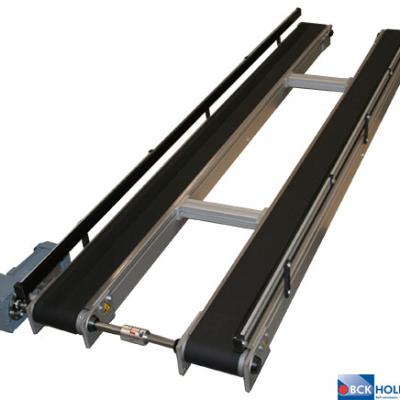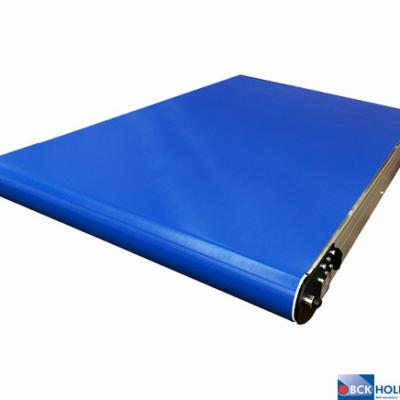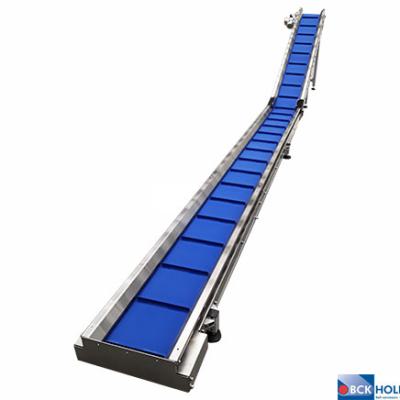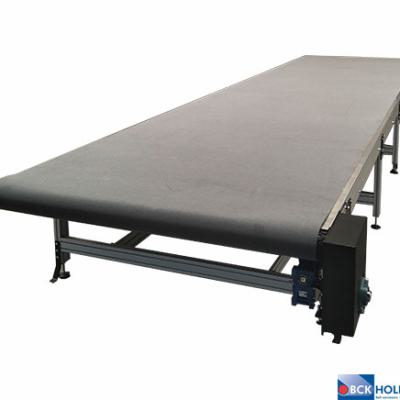Belt conveyors
A belt conveyor, also called a conveyor belt, is a conveyor system with belt material as the product carrier. The belt material is tensioned so that the drive drum grips the belt material. A belt conveyor is mainly used to move a product from A to B automatically. A belt conveyor is also used to transport products in progress past workers, robots, production machines or other packaging machines. The BCK belt conveyors have a modular construction, which enables BCK Holland B.V. to deliver custom-made products with standard components. The application often determines whether it should be an aluminium or a stainless steel belt conveyor.
Types of belt conveyors
Every product or environment requires a different type of conveyor. BCK Holland produces made-to-measure belt conveyors. The application often determines whether it should be a belt conveyor with an aluminium or stainless steel frame. See below for our product range:
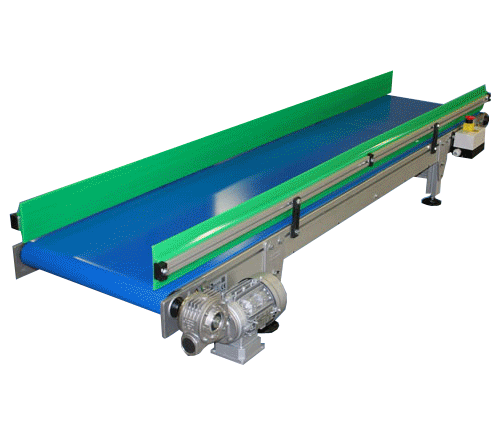
Aluminium belt conveyor
Environment: Dry and clean to slightly polluted
Load: Max. 300 kg
Speed: Max. 125 m/min
Roller diameter: Ø15 / Ø60 / Ø80 / Ø114 mm
Stainless steel belt conveyors
Environment: Dry to humid and clean to slightly polluted
Load: Max. 300 kg
Speed: Max. 125 m/min
Roller diameter: Ø15 / Ø60 / Ø81 mm
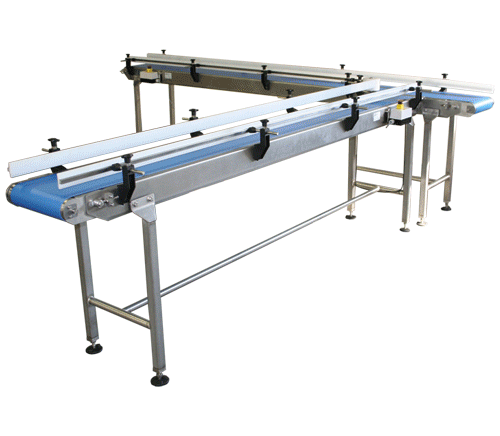
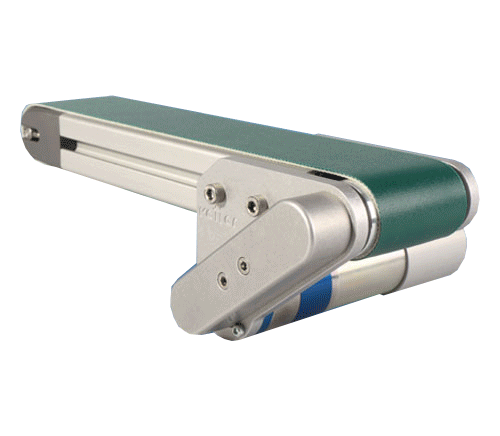
Mini-conveyors
Environment: Dry and clean
Load: Max. 10 kg
Speed: Max. 40 m/min
Roll diameter: Ø5 / Ø8 / Ø12 / Ø22 / Ø30 / Ø44 / Ø53.5 mm
Construction of a belt conveyor
A belt conveyor is a mechanical system used to efficiently move materials over short or long distances in various industries such as mining, construction, agriculture, and processing plants. It consists of several essential components that work together to make the conveyor belt function. Here is an overview of the main parts of a typical belt conveyor:
-
Frame: This is the sturdy base frame of the conveyor, usually made of steel or aluminum. It provides support to the other components of the conveyor and ensures stability and durability.
-
Drive Unit: The drive unit typically consists of an electric motor, gear motor, and coupling. The electric motor generates the power needed to set the conveyor belt in motion. The gear motor reduces the speed of the electric motor to achieve the appropriate driving speed level for the conveyor belt.
-
Conveyor Belt: This is the rubber belt that runs over the conveyor and carries the material. Conveyor belts can come in various widths, lengths, and thicknesses, depending on the application and the type of material being transported.
-
Drums: At the ends of the conveyor, there are drums that serve as the rollers over which the conveyor belt moves. The drive drum is powered by the drive unit and imparts motion to the conveyor belt, while the return or tail drum supports the belt and ensures proper guidance.
-
Tensioning Device: To maintain the correct tension on the conveyor belt and compensate for any stretching, a tensioning device is used. This may be a roller that supports the conveyor belt and is adjustable to achieve the right tension.
-
Support Rollers: These rollers support the conveyor belt and enable it to move smoothly along the length of the conveyor.
-
Material Infeed and Outfeed System: To get material onto the conveyor and take it off, infeed and outfeed hoppers, chutes, and other mechanisms are used, depending on the specific use of the belt conveyor.
-
Frame Covering: To protect the conveyor belt and the materials from weather conditions and environmental factors, a frame covering can be applied. This also helps minimize dust dispersion.
-
Control System: Modern belt conveyors are often automated and controlled by an electric control system. This allows for regulating the speed and direction of the conveyor belt, as well as the loading and unloading of materials.
All these components work together to provide efficient and reliable material handling by utilizing the rotational motion of the conveyor belt to move materials from one point to another. The design of the belt conveyor can vary depending on specific requirements and applications in different industries.
Why apply a belt conveyor?
A production company may apply a belt conveyor for several reasons, depending on the nature of the production process and the specific needs of the company. Here are some common reasons why a belt conveyor can be a valuable investment:
-
Efficiency and productivity: Belt conveyors can help automate the transportation of materials and products within the production process. This enables faster and more efficient movement of raw materials, semi-finished goods, and finished products, increasing productivity and reducing production lead times.
-
Cost savings: Utilizing belt conveyors can reduce labor costs as it requires fewer personnel for manually moving materials. Additionally, belt conveyors can be more energy-efficient than other forms of transportation, lowering energy consumption and associated costs.
-
Safety: Belt conveyors are designed with safety in mind. They come equipped with various safety features to prevent accidents, such as emergency stop buttons, protective enclosures, and monitoring systems. This helps ensure the safety of employees and reduces the risk of injuries.
-
Accuracy and consistency: Belt conveyors can move materials and products with precision and consistency, reducing the likelihood of errors and waste. This is particularly important in production processes where precision and uniformity are crucial.
-
Flexibility: Belt conveyors are available in various sizes and configurations, allowing them to be adapted to different production needs. They can be used for transporting different materials, such as bulk goods, packaged products, and even delicate or fragile items.
-
Space-saving: Compared to other transportation methods like roller conveyors, belt conveyors can offer more compact systems. This enables more efficient utilization of available space in a production environment.
-
Reduction of physical strain: The use of belt conveyors can reduce physical work for employees, especially when moving heavy materials over long distances. This can lead to less physical strain and decrease the risk of work-related injuries.
In summary, applying belt conveyors in a production company can enhance overall efficiency, safety, and productivity, resulting in cost savings and improved quality of production processes. However, it is essential for each production company to evaluate its specific needs and circumstances to determine if a belt conveyor is suitable for their particular situation.
Benefits for the user of BCK belt conveyors
Modular design;
- Customised configuration is possible;
- No special tools required;
- Saves time;
- Easy to reconfigure or expand for future applications;
- Solid and proven concept;
- Thoughtful components;
- Durable;
- Short payback period;
- Great problem-solving ability;
- Possibility for specials;
Reliable;
- Delivered as agreed;
- High delivery reliability;
- Proven safety;
- All dangerous moving parts are shielded;
- Clear safety instructions and comprehensive manual with CE or installation declaration.
Want to buy conveyors?
Are you interested in belt conveyors? BCK Holland has more than 15 years of experience in a wide variety of industries. That is why BCK Holland is able to give good advice and steer towards a good and affordable solution. Are you curious about the possibilities or prices of our belt conveyors? Contact us.
Rent a belt conveyor?
Would you like to rent a belt conveyor temporarily? BCK Holland has a number of conveyors available for temporary hire for a test or temporary production. Are you curious about the possibilities or prices? Contact us.
Photos belt conveyors
For inspiration or to estimate the possibilities at BCK Holland B.V., you can view many examples on this website.




